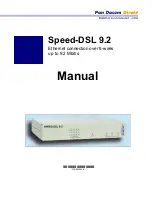
99
Chapter 8 - Modem Testing
8.2
Local Analog Loopback Test/V.54 Loop 3
In this test, data from your computer or terminal is sent to your modem's transmitter, converted into
analog form, looped back to the receiver, converted into digital form and then received back at your
monitor for verification. No connection to the phone line is required. See Figure 8-1.
Computer or Terminal
Local MultiModem
Digital
Analog
UUUUU
UUUUU
Figure 8-1. Local Analog Loopback Test
The test procedure is as follows:
1.
Connect the modem to your computer. With your communication software, set the desired baud
rate.
2.
Type ATU0 (or ATU) and hit ENTER. This places your modem in Analog Loopback mode, in the
Originate mode. The modem is now out of the Command mode and in a pseudo On-Line mode.
3.
Once you receive a connect message (if responses are enabled), enter data from your keyboard.
For this test, typing multiple upper case "U" characters is a good way to send an alternating test
pattern of ones and zeros.
4.
For a more complete test, you should also test the modem in Answer mode. To do this, you must
“escape” from Originate mode by entering an Escape Sequence (+++AT<CR> or
<BREAK>AT<CR>) . Then type ATU1 and hit ENTER to place the modem in Analog Loopback
mode, in the Answer mode. Then repeat step 3.
5.
When testing is completed, you may exit Answer mode by entering an Escape Sequence
(+++AT<CR> or <BREAK>AT<CR>), which returns the modem to Command mode.
6.
Your modem passes this test if the data entered from your keyboard is the same as the data
received on your monitor. If different data is appearing on your monitor, your modem is probably
causing the problem, although it could also be your computer. If your modem passes this test,
but you are receiving errors while On-line, the remote modem or the phone line could be at fault.
Summary of Contents for MultiModem II BA-Series
Page 1: ...BA Series Intelligent Data Fax Modem User Guide...
Page 6: ...vi...
Page 7: ...Chapter 1 Introduction and Description...
Page 18: ...18 MultiModemBA User Guide...
Page 19: ...Chapter 2 Installation and Connection...
Page 26: ...26 MultiModemBA User Guide...
Page 27: ...Chapter 3 Software Configuration and Modem Basics...
Page 34: ...34 MultiModemBA User Guide...
Page 35: ...Chapter 4 Manual Dial and Automatic Answer...
Page 40: ...40 MultiModemBA User Guide...
Page 41: ...Chapter 5 Command Mode...
Page 76: ...76 MultiModemBA User Guide...
Page 77: ...Chapter 6 S Registers...
Page 86: ...86 MultiModemBA User Guide...
Page 87: ...Chapter 7 Callback Security and Remote Configuration...
Page 96: ...96 MultiModemBA User Guide...
Page 97: ...Chapter 8 Modem Testing...
Page 106: ...106 MultiModemBA User Guide...
Page 107: ...Chapter 9 DIP Switch Settings...
Page 117: ...Chapter 10 Warranty Service and Tech Support...
Page 123: ...Appendixes...
















































